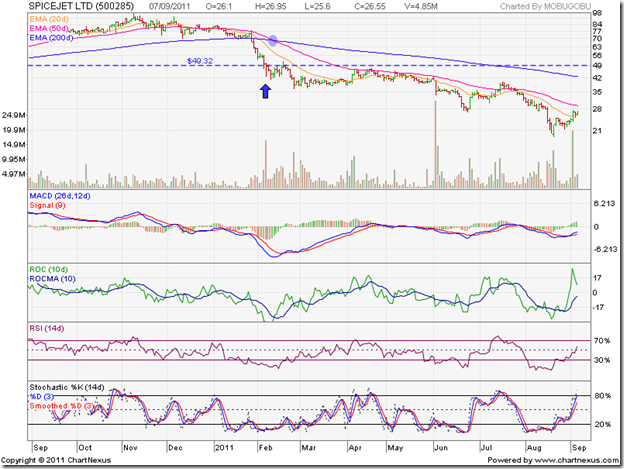What a difference a year can make! In the previous update to the analysis of the stock chart pattern of SpiceJet, I had mentioned about some fundamental changes in the company. The two most important ones were the replacement of financier Wilbur Ross by Kalanithi Maran of Sun TV fame (or, should I say notoriety?), and the departure of senior management personnel including CEO Sanjay Aggarwal.
Technically, the chart pattern was in a bull market – a long consolidation within a rectangle was followed by high volume break out to a new high of 79 – with a 100% gain in less than a year. A correction had ensued, but I had expected the stock price to recover and test its Jan ‘08 peak of 105. The analysis was concluded with the following notes of caution:
”Keep a trailing stop-loss and ride the bull. But remember that experienced airline hands have left the organisation. The new owners have political clout, which is great for wheeling and dealing but not so great for success in a complex and competitive industry which requires constant capital infusion, and globally doesn’t make much money.”
A look at the one year bar chart pattern of SpiceJet should convince readers that my warning was appropriate:
The stock couldn’t cross the 100 mark, reaching a top of 97.45 on Nov 8 ‘10 – which turned out to be a high volume ‘distribution day’ (a higher high but a close near the day’s low opening price). The subsequent correction took the stock price below the 50 day EMA, followed by a good recovery to a lower top of 92.70 on Dec 6 ‘10 – which turned out to be another high volume ‘distribution day’. That was the signal for bulls to exit.
A quick drop to the rising 200 day EMA was followed by a milder upward bounce and then a drift down to the 200 day EMA where the stock spent several trading sessions. The decisive break below the 200 day EMA on Jan 27 ‘11 led to increasing volumes as the stock dropped to the support level of 49 (the lower edge of the rectangular consolidation zone between Dec ‘09 and Jul ‘10).
Note the huge spike in volume as the stock breached the support of the 49 level (marked by the blue arrow) on Feb 7 ‘11. The high volume was a signal that the breached support would become a strong resistance. Shortly thereafter, the 50 day EMA crossed below the 200 day EMA (marked by the light blue oval) – the ‘death cross’ formally confirming a bear market. A pull back to the 49 level culminated with an intra-day breach on Feb 17 ‘11 – which was a ‘reversal day’ that provided another opportunity to sell.
Two more attempts at a pull back to the 49 level in Apr ‘11 were thwarted by the falling 50 day EMA. The stock has been dropping deeper into a bear market, touching a 2 year low of 19.30 on Aug 19 ‘11 that was an 80% correction from its Nov ‘10 peak of 97.45. The technical indicators are showing bullish signs, but it is a bear market rally that may attract more selling.
There is a well-known joke about the airline industry: If you want to become a millionaire in the airline business, you should start with a billion. Vijay Mallya’s Kingfisher Airlines is a classic example. SpiceJet is no exception – except for the brief period when the Ross-Aggarwal team was at the helm. The number of air-passengers are increasing day-by-day. That doesn’t mean that the business is a profitable one.
Bottomline? The stock chart pattern of SpiceJet is deep within a bear market, and in danger of becoming a penny stock. The DMK’s loss in the recent state assembly elections in Tamil Nadu has negated the considerable political clout of the Marans. Their only hope will be the appearance of a white knight who can bail them out. But don’t count on it. Get out if you are still holding.

No comments:
Post a Comment